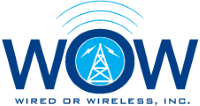Technical Support Hub
BEFORE CALLING TECHNICAL SUPPORT
Please review the items below before calling Tech Support. Our technical team will ask if you have performed these basic trouble-shooting items when they first speak with you.
Our technical support department is available 8AM-8PM Monday thru Friday, and 10AM-8PM on weekends and holidays. If you call after regular business hours, please leave a message in the tech support voicemail box with your name and phone number clearly given and brief information on your issue. A technician will call you back.
Sometimes there may be an outage in your area due to weather or power outage. To check if you’re in one of these areas, please view known outages here .
If you are still experiencing technical difficulties,
please call 509-892-2482.

HELP! MY INTERNET ISN'T WORKING
Troubleshooting steps that can help identify a connection issue:
1. Check Other Websites
Make sure the issue is the Internet connection and not an issue with opening a specific website. Go to other websites you don't normally visit and try to open them.
2. Reboot Your Computer
Go to the Start menu and choose shut down. Turn your computer off completely, wait for 30 seconds and turn the computer back on.
3. Make Sure Power is Being Supplied to the Installed Equipment
A flat black cable about 4 inches long will be either connected directly into the back of your computer or into your router. From that point there will be a small junction connected to a skinny black cable continuing to a larger square black base plugged into a nearby outlet. This POE (Power Over Ethernet) cable supplies power to the WOW equipment outside. If there is a power outage at your home or business, or the POE has been unplugged, you will lose your Internet connection. Make sure the POE is securely plugged into the designated outlet. A green/yellow light should be glowing which indicates it has power.
4. Power Cycle Your Router and POE (Power Over Ethernet)
Leave your computer turned on. Locate your router and POE and unplug them from their power sources. Wait for 30 seconds then plug the POE back into the outlet. Wait for 1 to 2 minutes then plug the Router back into the outlet. If you do not have a router then follow the above directions for the POE only, then attempt to get online.
HELP! MY INTERNET IS SLOW
Internet speeds can vary for different reasons, try troubleshooting your unique home situation and making sure your expectations are correct. Run a speed test from a computer that's hard-wired, making sure no other devices are Wi-Fi connected, and compare the results. If that device provides the speeds you expect, you have a Wi-Fi problem. Most slower Internet Speeds are a result of Wi-Fi issues.
Remember that if there are background programs or other devices using your network resources, your test results will appear low even though you are getting the bandwidth you are supposed to be getting. A speed test only shows the bandwidth available to the device it is run on — not bandwidth allocated and being used by your other devices.
1. Make sure your device is as close to your home-access-point as possible.
Walls and large household items can have a huge affect on a devices speed. Different rooms in a house will have different speeds because of distance and walls.
2. Connecting directly to our cable will bypass any router or wi-fi issues. Just remove the Ethernet cable from the WAN or Internet port of your router and connect it directly into the Ethernet port on your desktop or laptop.
3. Check to see how many devices are connected to the Internet.
Remember that visitors and kids can each have 3-5 active devices each. The more devices, the slower the speed on each device. One client called and discovered with grandkids over at his house, he had 24 devices connected to the internet at once.
4. Run a Speed Test
Test your Internet speed. Make sure you are the only person online when you run the test. There are many FREE speed test websites – one is provided on the button below.
4 THINGS YOU SHOULD KNOW ABOUT INTERNET SERVICE
- It's Not Your Connection; it's a high use time for the network.
A speed test can indicate your connection is capable of certain data rates but doesn't mean you'll always get them. You're not the only home or business connecting to the service, there can be peak times when everyone is using the bandwidth. This can temporarily slow your individual speeds. This doesn't mean there's something wrong with your connection, this is why WOW is continually upgrading the network to provide more bandwidth to every subscriber.
- Your computer is downloading, whether you know it or not – BitTorrent to Microsoft and Apple.
Most homes have multiple devices connected to the Internet. It’s easy to forget or not know about a “Bandwidth Hog” being on your connection. This includes favorite sites like BitTorrent to main applications like Windows, OS X, Linux and Apps. These products and sites download updates and grab data from your devices without most people knowing it. Over 20% of Internet usage is not asked for or recognized by normal residential Internet user. You can limit this behind the scenes activity through preference settings on each device. Lots of programs and apps can run in the background and slow things down.
- Your Router needs attention.
Like most technology or mechanical things, a router needs occasional attention. Think of the Router as a mini computer that managers all the information going to each device. Many routers require a regular restart. Be aware that routers don’t last a long time and when they go they don’t just outright die instead they start to preform at 75% or 50% of capacity. They fail slowly. Just like an old car that becomes a gas -guzzler before it actually won’t start. Most residential and business users won't notice this decline in performance immediately. Pay attention to your router, and you will be able to maintain better upload and download speeds.
- Neighborhood Interference can impact your speeds.
Routers have settings that allow you to change the Wi-Fi channel to help avoid interference. In some cases, you can even boost it’s transmit power or avoid a channel that has too many other users. Apartment complexes and office buildings are the worst. The close proximity of Internet users and networks makes interference a real issue. It might not be your connection or service, but who is around you and all of their services interfering with yours. Often times, a small adjustment to your Wi-Fi channel can have a huge impact on improving performance.
